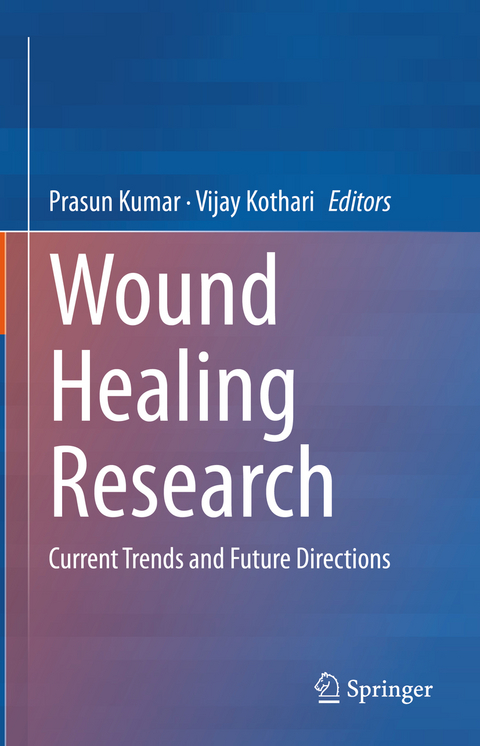
Wound Healing Research
Springer Verlag, Singapore
978-981-16-2676-0 (ISBN)
This book presents the latest knowledge on both the physiological and the microbiological aspects of wound healing. Fresh insights into the process of cutaneous wound healing are described, which involves tissue regeneration and repair processes consisting of a sequence of molecular and cellular events. The management of infected wounds is then discussed in detail, covering the roles of traditional medicine practices, novel anti-infective formulations, non-antibiotic approaches, and probiotic bacteria. A section devoted to the interdisciplinary approach to wound care addresses topics including in vitro and in vivo research models, the development of advanced wound dressings, tissue engineering, and the potential applications of bioscaffolds. The authors are all leading researchers in the field. This book is an attempt to showcase current research status and future directions in the area of wound-healing research, which must be of interest to a large group ofreaders and researchers interested in this field.
Prasun Kumar is presently working as an Assistant Professor at the Department of Chemical Engineering, Yeungnam University, Republic of Korea. He holds a Ph.D. in Biotechnology from CSIR-Institute of Genomics and Integrative Biology, Delhi, India. His main areas of research are biopolymers, microbial biodiversity, bioenergy, microbial biofilms, quorum sensing, quorum quenching, and genomics. He has over seven years of experience in applied microbiological research including over 2 years postdoctoral research experience as BK-21 plus fellow at Chungbuk National University, Republic of Korea. His research work is oriented towards valorization of lignocellulosic biowastes into value-added products and antibiofilm compounds. To his credits, there are over 29 articles in various peer-reviewed SCI journals including Trends in Microbiology, Biotechnology Advances, and Bioresource Technology. To date, his work has fetched decent citations with an h index of 24 and an i10 index of 33. He has been contributing to scientific society by actively reviewing articles for more than 32 SCI journals and was awarded the peer review award by Publons in the year 2018. He serves as the editorial board member of few international journals and also worked as the guest editor for the journals, namely ‘Polymers’ and ‘Frontiers in Bioengineering and Biotechnology’. Vijay Kothari is a microbiologist. His primary research interest is AMR (antimicrobial resistance). His group is actively involved in investigating antimicrobial/ anti-virulence potential of natural products as well as synthetic compounds. In recent past, his lab has extensively investigated the anti-pathogenic activity of various traditional medicine formulations e.g. Panchvalkal, Panchgavya, Triphala, etc. against different antibiotic-resistant bacterial strains including the wound-infective species. His lab was awarded SRISTI-DBT-BIRAC Appreciation Award for validation of anti-infective potential of a traditional polyherbal formulation- Herboheal. He has also been awarded two AIMS (Artificial Intelligence Molecular Screen) award projects by Atomwise Inc., USA for identifying novel anti-infective leads. Dr. Kothari has also contributed substantially to the field as an active editor and reviewer, and has been conferred the Sentinel of Science award by Publons in 2016 recognizing his contribution as a peer reviewer.
Part I: Cellular and physiological aspects of wound-healing.- Chapter 1:Classification of wounds and the physiology of wound healing.- Chapter 2:Mechanisms of collective cell migration in wound healing: physiology and disease.- Part II: Natural products in the management of infected wounds.- Chapter 3: Natural products as Wound healing agents.- Chapter 4: Wound healing agents from natural sources.- Chapter 5: Wound healing: Understanding honey as an agent.- Chapter 6: Role of medicinal plants in wound healing: An ethnopharmacological approach.- Chapter 7: Mainstreaming Traditional Practices for Wound-Management.- Chapter 8: Traditional Probiotics, Next-Generation Probiotics and Engineered Live Bio-Therapeutic Products in Chronic Wound Healing.- Chapter 9: Role of probiotics in wound healing.- Chapter 10: Use of probiotic bacteria and their bioactive compounds for wound-care.- Chapter 11: Development of novel anti-infective formulations for wound disinfection.- Part III: Interdisciplinary approach to wound-care.- Chapter 12: Silversol® a nano silver preparation: a multidimensional approach to advanced wound healing.- Chapter 13: Preclinical models for wound-healing and repair studies.- Chapter 14: Chronic wounds: an overview of wound healing and experimental models for wound studies.- Chapter 15: Experimental wound-care models: in vitro/in vivo models and recent advances based on skin-on-a-chip models.- Chapter 16:Potential Biomedical Applications of Marine Sponge Derived Chitosan: Current breakthroughs in Drug Delivery for the Wound Care.- Chapter 17: Biomedical applications of biodegradable polymers in wound-care.- Chapter 18: Role of biodegradable polymer-based biomaterials in advanced wound care.- Chapter 19:Atmospheric Pressure Plasma therapy for wound healing and disinfection- A Review.- Chapter 20: Quorum sensing as a therapeutic target in the treatment of chronic wound infections.- Chapter 21: Biofilm: A Challenge to Overcome in Wound Healing.- Chaper 22: The potential of essential oils as topical antimicrobial agents in the age of artificial intelligence.
| Erscheinungsdatum | 23.07.2021 |
|---|---|
| Zusatzinfo | 91 Illustrations, color; 3 Illustrations, black and white; X, 694 p. 94 illus., 91 illus. in color. |
| Verlagsort | Singapore |
| Sprache | englisch |
| Maße | 155 x 235 mm |
| Themenwelt | Medizin / Pharmazie ► Gesundheitswesen |
| Studium ► 1. Studienabschnitt (Vorklinik) ► Physiologie | |
| Naturwissenschaften ► Biologie ► Zellbiologie | |
| ISBN-10 | 981-16-2676-6 / 9811626766 |
| ISBN-13 | 978-981-16-2676-0 / 9789811626760 |
| Zustand | Neuware |
| Informationen gemäß Produktsicherheitsverordnung (GPSR) | |
| Haben Sie eine Frage zum Produkt? |
aus dem Bereich


